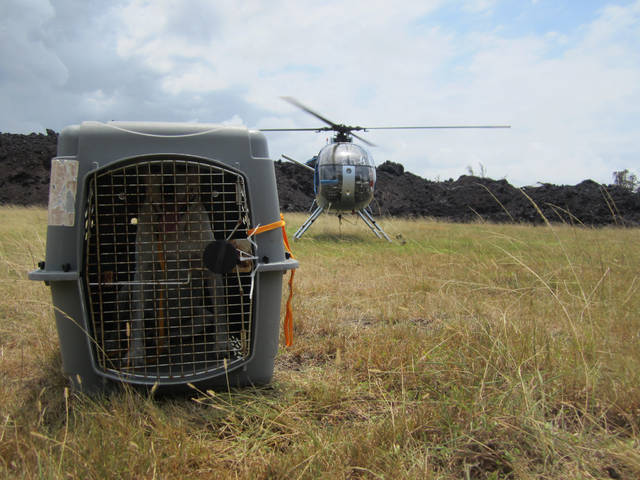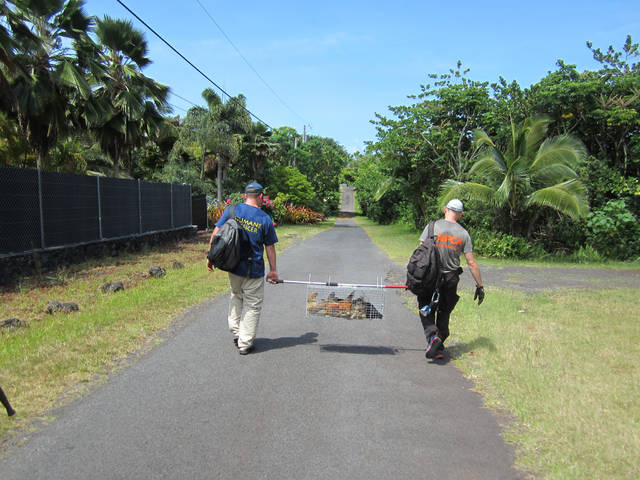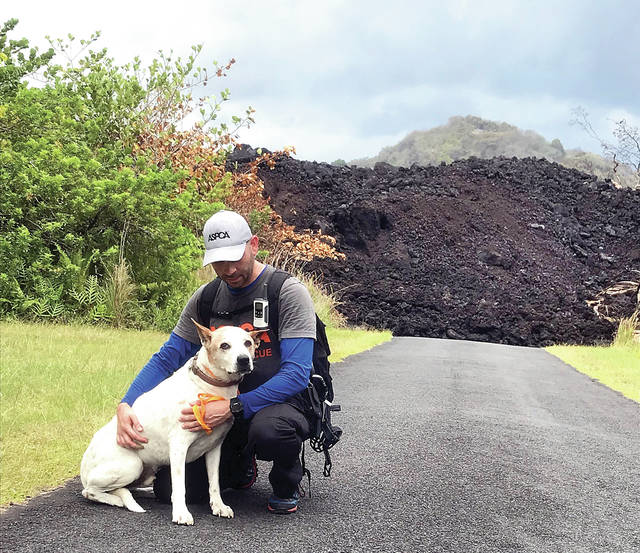More than a month after volcanic activity began disrupting life in lower Puna, teams are still striving to rescue animals that remain in the lava zones.
On Thursday, an animal search-and-rescue team led by the Hawaii Island Humane Society and American Society for the Prevention of Cruelty to Animals removed — sometimes by helicopter — more than a dozen animals, including birds, sheep, cats and a dog, from Kapoho Beach Lots.
According to the ASPCA, these animals were transported to the Humane Society’s Keaau shelter, where they will receive care until reunited with their families.
“These search-and-rescue efforts are absolutely critical to safely remove animals trapped in areas completely cut off by active lava fields and steep banks,” Dick Green, senior director of ASPCA Disaster Response, said. “The ongoing and relentless destruction caused by the Kilauea volcano eruptions has put hundreds of animal lives at risk, and the ASPCA is pleased to be in a position where we can partner and assist the Hawaii Island Humane Society to save as many displaced animals as possible.”
According to Green, the ASPCA Field Investigations and Response team deploys nationwide to assist in relocation, search-and-rescue, sheltering and placement of animals during disaster situations.
The HIHS has deployed up to eight animal control officers each day when given access to search for animals, HIHS executive director Donna Whitaker.
“We’ve gone door-to-door in the subdivision in our search for animals at risk and continue to leave food and water for those animals not yet found and rescued,” she said.
As of Friday, Whitaker said the HIHS has rescued more than 165 animals, nearly all of which have been reunited with owners, with the remaining animals sheltering in foster homes.
A flyover of the eruption areas and an on-the-ground evaluation in Leilani Estates were done last Monday to look for remaining animals, days after a community meeting was held by the HIHS and ASPCA to discuss efforts to survey the affected areas and ways to improve communication among residents, rescue organizations and government entities.
Whitaker said that the meeting aimed to “get everybody on the same page” and to gather ideas from the community.
The HIHS has had challenges with communication and access to the evacuated areas, she said, but Green has “a lot of experience particularly in working through emergency response processes. … I invited them over to help with that process, and they’ve been a huge help.”
Until the lava activity expanded beyond Leilani, Whitaker said “everyone was doing OK, then it got so much worse so quickly. That’s why I invited (the ASPCA) here (on June 3).”
Other organizations have been assisting in the efforts, too.
According to notes collected from the recent community meeting, which were shared by Green in an email provided to the Tribune-Herald by an area rescue organization, Rainbow Friends Animal Sanctuary has helped 400 families since May 3, and dozens of feral cats have been relocated, Aloha Ilio has taken in 50 dogs and some cats, while the Hui Pono Holoholona Rescue, which is primarily a feral cat rescue, has taken in 50 cats, many with eye issues due to the ash and gases.
In a follow-up email, Green said there are likely feral cats, chickens and other domesticated animals still in the evacuated zones, and he has received word that there are backyard livestock still in those areas, too, although the search-and-rescue team has not seen them.
“In situations like this and on this island, there could be a significant number of cats that have not spotted and the possibility of dogs that have not yet been captured,” he said.
Efforts have also extended online.
Laurie Lyons-Makaimoku, of Orchidland, is one of several administrators of the Hawaii Lava Flow Animal Rescue Network group on Facebook, a grassroots movement that currently has more than 3,500 members from around the world.
“Originally, we kind of all came together for that idea of rescuing animals inside (the evacuation area),” she said, but because they’re not an official rescue group, there were challenges that came with that.
Instead, they’ve been able to work closely with HIHS “and try to support them, especially when it comes to information,” Lyons-Makaimoku said.
Their mission as a network is to help gather and provide pet- and animal-related information, but Lyons-Makaimoku said their focus has shifted a bit more to “making sure the animals that are out are taken care of” and short-term needs are addressed.
The six group admins work nearly 20 hours a day, she said. A GoFundMe account helps cover animal-related expenses, and they also provide information on resources and referrals.
Lyons-Makaimoku said she considers the group a sort of “social service agency for the animals.”
“It’s really amazing, and it’s really inspiring,” she said. The “group as a whole is a very inspirational place and I feel really, really fortunate to be a part of it.”
The group can be found online at facebook.com/groups/HLFARN and the GoFundMe page can be found at gofundme.com/hlfarn.
Rainbow Friends Animal Sanctuary in Kurtistown is another group providing rescues, medical care and sheltering of pets displaced as a result of recent lava flows in Puna.
The group announced Wednesday it had been awarded a $10,000 grant from the Petco Foundation to support its disaster relief work.
“The Disaster Relief grant of $10,000 from the Petco Foundation is a life-saver to cover the extraordinary expenses of assisting our island pets,” Rainbow Friends founder and President Mary Rose Krijgsman said in an announcement Wednesday. The Petco Foundation also matched $1,000 raised at a recent fundraising event benefiting the Sanctuary.
Access and response
Prior to the increased activity in Kapoho, Whitaker said the HIHS had been given access into the lava zones when they received reports of animals, but now they must request access to restricted areas from Civil Defense.
The organization has been working with the mayor’s office and Civil Defense “to work within their processes to be able to get access to some of these areas,” she said. “It’s a slower process than we would like, but we are able to get in there to check on and remove these animals.”
However, the HIHS can only request access if requested by the homeowner and must have permission to be on their property.
“Because it’s been so dangerous, Civil Defense’s first priority is safety and that’s why access became more of an issue, and so Dick (Green) is here helping us and Civil Defence wade through the process,” said Whitaker.
Response plans change each day, she said.
“We are looking at (the) geographical area and creating plans of how to get in there. … Every day’s plan is different depending on what area we’re going in.”
At full capacity, Whitaker said there’s room for about 150 dog and 75 cats at the HIHS’ Keaau shelter, while there’s room for about 75 dogs and 50 cats at the Kona shelter and 35 dogs and 30 cats at the HIHS shelter in Waimea.
“We have identified a couple of areas where we can add more kennels, and they are on order,” she said.
As of Wednesday, Whitaker said there are about 50 dogs and 25 cats, as well as several “pocket pets,” like bunnies and guinea pigs, in the shelters that were owner-surrendered, not related to the lava. There have been “very few” owner surrenders as a result of eruption activity.
“As much as possible, if you are needing to leave, take your pets with you, because really, nobody knows what’s going to happen and the last thing we want to do is put anyone in harms way. … We don’t want people to be separated from their pets.”
Disaster-related animals will be housed at the Keaau shelter for 30 days to allow for reunification with their owners.
Email Stephanie Salmons at ssalmons@hawaiitribune-herald.com











